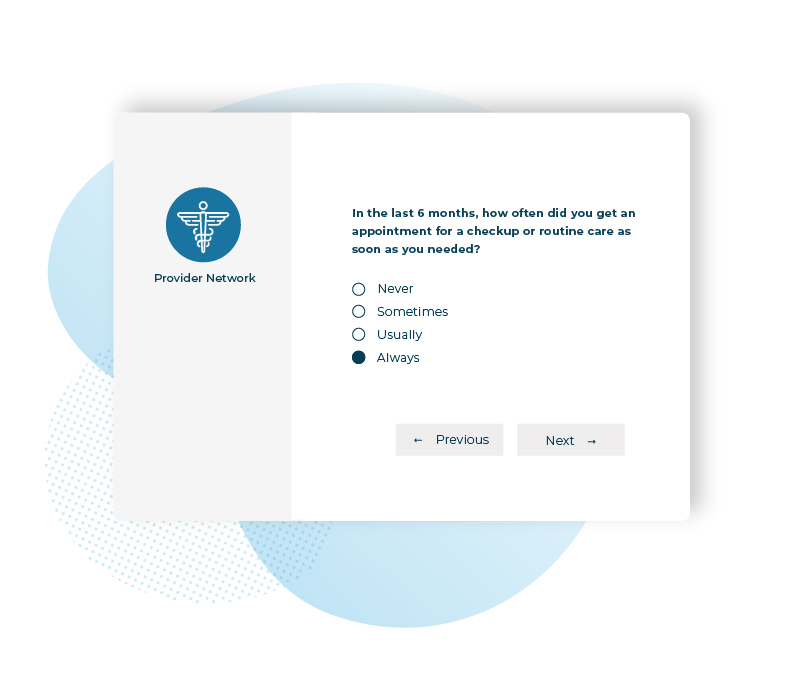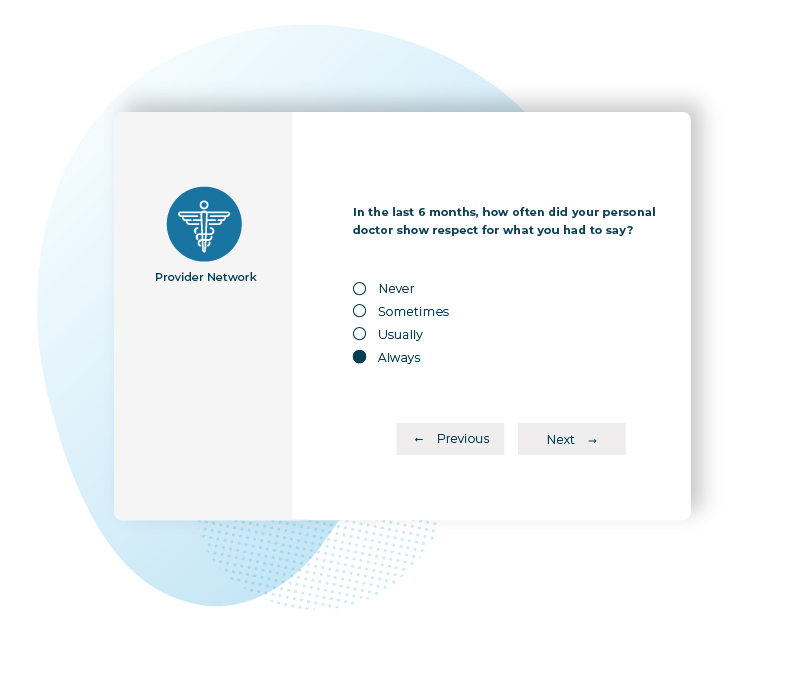In case you missed it, we recently provided a comprehensive overview of Medicare Advantage (MA) CAHPS surveys and shed light on why they matter to carriers and providers. This annual survey is sent out to MA members in the following categories: Medicare Advantage (MA-Only), Medicare Advantage Prescription Drug plan (MA-PD), and Stand-Alone Medicare Prescription Drug Plan (PDP). MA members enrolled in any of these plans for six months or more are eligible to participate in these surveys.
These MA CAHPS surveys aim to understand the enrollee’s demographics, healthcare over the last six months, doctor, specialists, health plan, and/or prescription drug plan. Since this covers a large amount of information underneath several broad concepts, CMS calculates composite measures to comprehend several data points to inform both contracts and consumers. Generally speaking, the questions are given equal weight when calculated into a single composite measure.
The following six composite measures are calculated on these surveys:
- Getting Needed Care
- Getting Appointments and Care Quickly
- Doctors Who Communicate Well (not reported to consumers)
- Customer Service
- Getting Needed Prescription Drugs (MA-PD and PDP)
- Care Coordination
Though all six of these composite measures paint an important picture, we recommend that provider networks focus on the first three composite measures (Getting Needed Care, Getting Appointments and Care Quickly, and Doctors Who Communicate) as direct means to increase quality of care and scores. The provider’s ability to impact scores requires a keen understanding of these three composite measures. By understanding which questions are asked, they can begin strategizing how to do so.
Composite Measure 1: Getting Needed Care
The first composite measure, “getting needed care” concerns a member’s success with acquiring the medical care they seek, in addition to seeing specialists, if necessary. Again, this is an important area to shed light on as members want to choose plans that facilitate the care they need in a timely manner.
Members can choose from the following answers: “never, sometimes, usually, always.” Below are two examples of questions used to calculate the “Getting Needed Care” composite measure:
In the last 6 months, how often was it easy to get the care, tests or treatment you needed?
In the last 6 months, how often did you get an appointment to see a specialist as soon as you needed?

It is important to remember that members answering these questions may have only seen a doctor once. So whether or not the patient has regular appointments or visits one time, quality of care matters. By providing ease of care, members will have a positive experience, thus impacting CAHPS scores and reimbursement rates.
Composite Measure 2: Getting Appointments and Care Quickly
The second composite measure is focused on the speed at which patients can get appointments. Additionally, once they are in the office, the survey inquires about the speed at which they are seen when they arrive at a provider’s office. Since MA enrollees are elderly and may be uncomfortable sitting for long periods or have a condition that requires immediate care, it is critical that they be seen promptly.
Below are a few examples of questions members are asked, again with response choices of “never, sometimes, usually, always:”
In the last 6 months, when you needed care right away, how often did you get care as soon as you needed?
In the last 6 months, how often did you get an appointment for a checkup or routine care as soon as you needed?
Wait time includes time spent in the waiting room and exam room. In the last 6 months, how often did you see the person you came to see within 15 minutes of your appointment time?

To the best of their ability, providers should communicate with members about scheduling challenges and expected wait times. Displaying clearly marked signs in the waiting room to encourage members to check in with the front desk if they haven’t been seen in 15 minutes is one avenue to combat this frustration.
Composite Measure 3: Doctors Who Communicate Well
This composite measure, unlike the others, is reported to contracts only. This data empowers carriers to assess the quality of care from providers and adjust accordingly. This is arguably the most crucial measure of all six composites. Providers significantly impact scores; if underperforming, they will soon become aware of it.
Below are a sample of questions from these CAHPS surveys, also with the possible answers, “never, sometimes, usually, always:”
In the last 6 months, how often did your personal doctor explain things in a way that was easy to understand?
In the last 6 months, how often did your personal doctor listen carefully to you?
In the last 6 months, how often did your personal doctor show respect for what you had to say?
In the last 6 months, how often did your personal doctor spend enough time with you?

As anyone who has been to a doctor before knows, the importance of bedside manner cannot be understated. The demographic of MA members needs providers who communicate in a way that these patients feel, heard, understood, and respected. Refining these soft skills and managing their caseload to be as informed as possible will help to ensure quality of care. Providers should have a solid understanding of the patient they are treating by being fully informed of their patient’s appointments with specialists.
How Continuous Surveying Can Affect Composite Measures
These three composite measures encapsulate a member’s experience with their provider network. Unfortunately, due to the fact that these surveys are annual, this information will surface at a time when it may be too late to impact CAHPS scores. However, continuous surveying will allow provider networks to be aware of improvements that can be made on a more regular basis. The bottom line is that awareness of member experience through customized surveys can result in higher scores and better health care.
Brenmor offers continuous survey options with individualized monthly summaries to keep every provider informed. Want to know more? Speak with an expert today.
